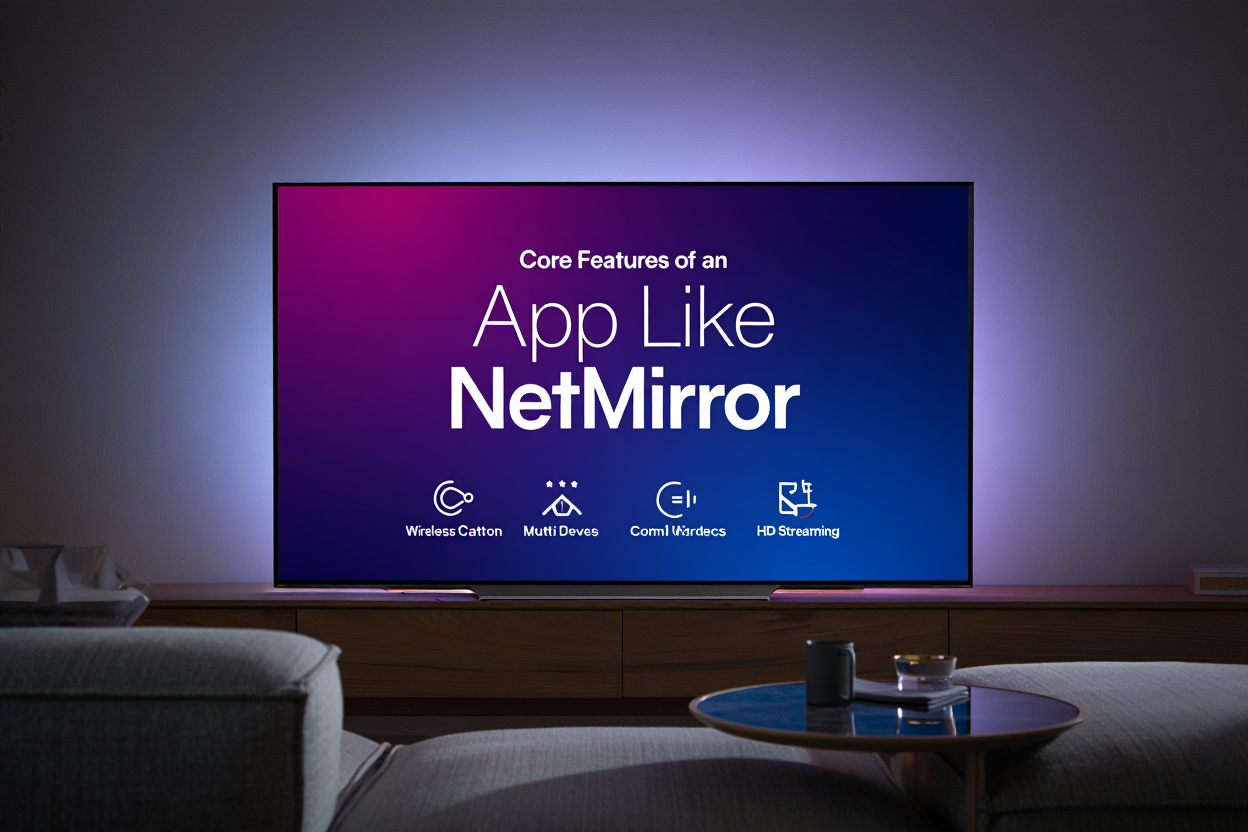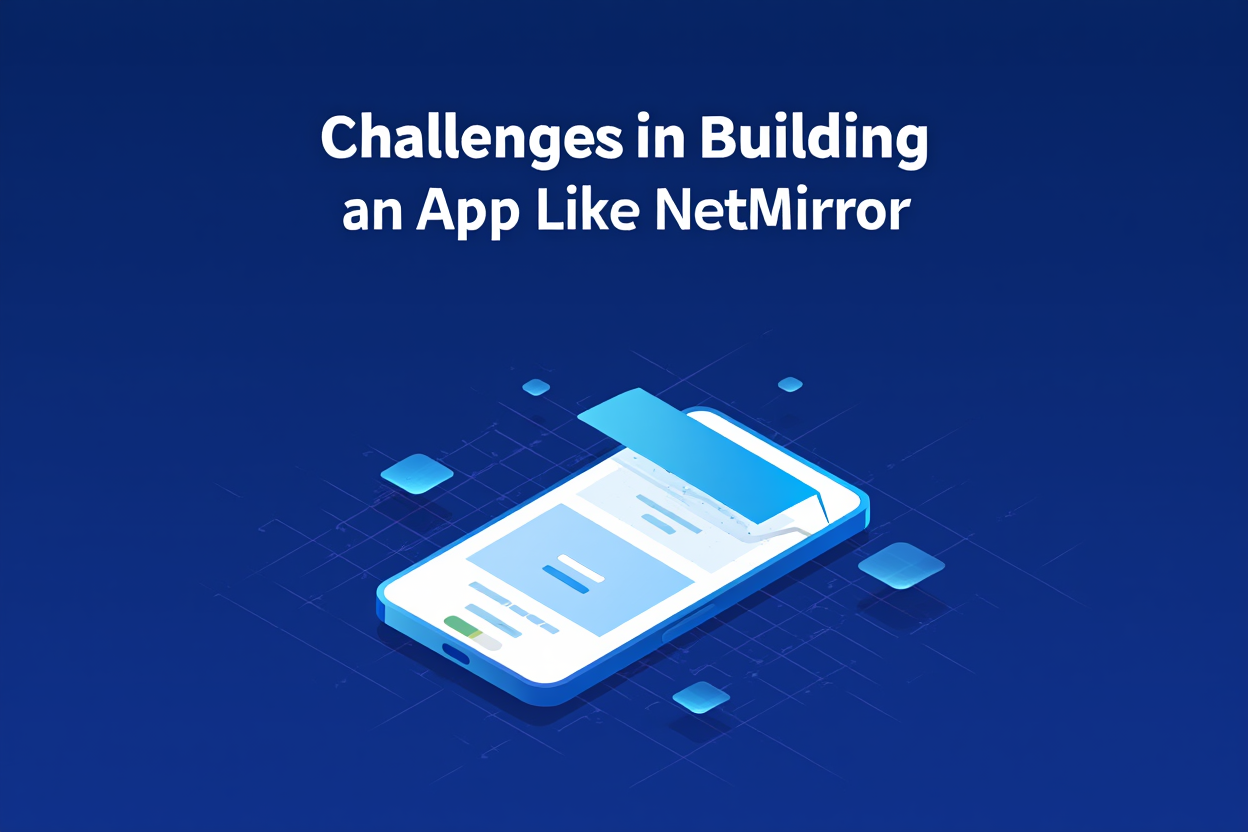
In the last decade, the way people consume digital content and collaborate across devices has changed dramatically. From students attending online classes on laptops and casting lessons onto TVs, to professionals conducting presentations directly from smartphones, seamless device connectivity has become an essential part of modern life. Among the many tools that support this shift, screen mirroring apps stand out as powerful enablers of convenience and productivity.
Table of Content
One such app making waves in 2025 is NetMirror, known for its ability to mirror and cast screens across smartphones, laptops, desktops, tablets, and smart TVs with minimal lag and superior quality. Unlike older mirroring tools that often struggled with latency and compatibility issues, NetMirror provides a smooth and secure experience for personal, educational, and professional use cases.
With the growing reliance on remote work, hybrid education, gaming, and streaming, the demand for apps like NetMirror is only increasing. Businesses and startups are seeing an opportunity to enter this space by offering innovative features, faster connectivity, and secure platforms. Whether it’s a screen-mirroring app, a video-sharing tool, or even a Netflix clone, the market is full of possibilities. If you’re planning to build an app like NetMirror, 2025 is the right time to leverage this fast-growing market.
This blog will take you through a complete roadmap on how to create an app like NetMirror—from understanding the technology and features to exploring development processes, costs, challenges, and future opportunities. By the end, you’ll have a clear picture of what it takes to design, develop, and launch a powerful screen mirroring app in today’s competitive environment.
At its core, NetMirror is a screen mirroring and casting application that allows users to project the screen of one device onto another seamlessly. Whether you want to watch a movie from your phone on a smart TV, share a presentation from your laptop to a conference room projector, or even mirror your gaming screen onto a larger display, NetMirror makes it effortless.
The concept of screen mirroring is not new. Early solutions like HDMI cables or VGA connectors were hardware-dependent and restricted by device compatibility. Later, software-based technologies like DLNA, Miracast, Chromecast, and AirPlay revolutionized screen sharing by eliminating physical connections. However, most of these solutions were tied to specific platforms or had performance limitations.
NetMirror emerged as a platform-agnostic solution, capable of running across iOS, Android, Windows, macOS, and smart TV operating systems. By leveraging advanced protocols and cloud-based integrations, it delivers low-latency and high-resolution streaming that fits both consumer and enterprise needs.
Because of these strengths, entrepreneurs and developers aiming to develop an app like NetMirror can tap into multiple industries—from entertainment and education to enterprise collaboration. The ability to make an app like NetMirror that goes beyond simple casting and adds advanced, user-focused features can position a startup as a strong competitor in this growing market.

The screen mirroring and casting app industry has grown beyond a niche technology into a mainstream digital necessity. With remote work, online education, gaming, and smart entertainment becoming everyday essentials, demand for robust solutions like NetMirror is skyrocketing. Understanding the market trends of 2025 is crucial if you want to develop an app like NetMirror that can capture user attention and stay ahead of the competition.
Households are no longer limited to one or two screens. Smart TVs, projectors, and IoT-enabled displays are becoming standard in homes, offices, and classrooms. According to Statista, by 2025, the global number of smart TV households is expected to cross 1 billion, with adoption growing fastest in Asia-Pacific and North America.
This surge in smart devices directly fuels demand for apps that allow seamless screen casting and mirroring. Whether it’s a teacher displaying lessons on a classroom projector or a family streaming movies on a living room TV, solutions like NetMirror provide the bridge. For developers planning to create an app like NetMirror, ensuring compatibility with this expanding ecosystem is a critical success factor.
One of the biggest challenges in earlier screen mirroring apps was latency. With the arrival of 5G networks and Wi-Fi 6 technology, users can now enjoy ultra-low latency streaming, even for bandwidth-heavy applications like gaming or live presentations.
For businesses aiming to make an app like NetMirror, leveraging these technologies means delivering a truly smooth experience that feels instant and lag-free. This advantage not only attracts gamers but also professionals who cannot afford delays during presentations or collaborative sessions.
Screen mirroring in 2025 is no longer restricted to flat screens. The rise of augmented reality (AR) and virtual reality (VR) is transforming how content is shared and consumed.
Imagine students mirroring their AR biology experiments to a classroom projector, or enterprises sharing VR-based training sessions across devices in real-time.
For developers looking to build an app like NetMirror, AR/VR compatibility opens up new revenue streams and user engagement possibilities. By integrating immersive technologies, screen mirroring apps can serve industries ranging from healthcare and education to gaming and retail.
Startups that develop an app like NetMirror with tailored features for these sectors stand a higher chance of capturing loyal customer bases.
These numbers highlight why businesses are increasingly eager to make an app like NetMirror—the potential for growth is immense, and the technology is becoming indispensable.

Building a successful screen mirroring app is not just about enabling devices to connect; it’s about providing a seamless, secure, and engaging user experience. If you plan to build an app like NetMirror, incorporating both essential and advanced features is crucial for long-term adoption.
Multi-User Screen Sharing
Imagine a corporate meeting where multiple participants can share their screens one after another without switching devices manually. Multi-user sharing adds a collaborative edge.
Cloud Streaming Integration
Instead of relying solely on local devices, users can stream directly from the cloud (Google Drive, OneDrive, Dropbox) to larger displays. This adds flexibility and appeals to business and education sectors.
Voice and Gesture Control
With smart homes and AI assistants gaining traction, integrating voice commands or gesture-based controls makes the app future-ready. For instance, a teacher could switch between slides using simple hand gestures.
Privacy and Secure Sharing (End-to-End Encryption)
Security is a major concern, especially for enterprises and schools. Implementing strong encryption ensures that private content is not intercepted or leaked during transmission.
Integration with Third-Party Apps (Zoom, Teams, YouTube, Netflix, etc.)
Instead of reinventing the wheel, developers can add value by integrating popular apps directly. A user could cast a YouTube video or a Zoom meeting in just a tap, making the app more versatile.
Offline Casting Options
In regions with limited internet connectivity, the ability to mirror content offline via direct peer-to-peer connections (like Wi-Fi Direct) is a game-changer.
By combining these essential and advanced features, developers can not only make an app like NetMirror but also enhance it to stand out in a crowded market. The key is to balance performance, security, and innovation while addressing real user needs.
Building a robust, high-performance screen mirroring app requires more than just coding—it demands strategic planning, the right technology choices, strong user experience design, and rigorous testing. If you are planning to build an app like NetMirror, here is a detailed roadmap that covers each stage of development.
Every successful app begins with a clear understanding of its audience and market positioning.
By conducting thorough research, you create the foundation needed to develop an app like NetMirror that is both relevant and scalable.
The choice of technologies determines how efficient, secure, and future-proof your app will be.
Choosing the right tech stack is crucial if you want to create an app like NetMirror that performs well across devices and networks.
A well-designed interface can be the difference between user adoption and app abandonment.
If your goal is to make an app like NetMirror, prioritizing user-friendly design ensures higher engagement and positive reviews.
The actual coding and system architecture form the backbone of your app. Development should be structured into clear stages:
Developers who plan to build an app like NetMirror should focus heavily on backend performance and streaming optimization, as user satisfaction depends on real-time responsiveness.
A mirroring app must undergo rigorous testing because even small lags or connection issues can ruin the experience.
Without robust testing, it’s nearly impossible to develop an app like NetMirror that delivers consistent results across diverse devices.
After development and testing, it’s time to bring the app to market.
A well-executed launch can position your app strongly against competitors. For example, if you make an app like NetMirror with cloud integration and market it to businesses, you can carve out a strong niche in enterprise productivity.

Building a powerful mirroring app is only half the journey; the other half is ensuring it generates sustainable revenue. If you plan to build an app like NetMirror, selecting the right monetization strategy is critical for long-term success. The model you choose should align with your target audience, market positioning, and app features.
This is the most popular strategy for apps like NetMirror.
Recurring subscriptions ensure a steady revenue stream.
Example: A business user might subscribe to access enterprise-grade security, unlimited casting, and team collaboration features.
Some features can be offered as one-time purchases.
This approach allows users to customize their experience without committing to recurring payments.
For free users, targeted ads can generate revenue.
One of the most lucrative opportunities lies in the enterprise sector.
Example: A university may purchase a licensed version for classrooms and lecture halls.
By combining these models strategically, startups can make an app like NetMirror that not only delivers great value to users but also builds a profitable, scalable business.

While the market potential is enormous, building a screen mirroring app is not without hurdles. Developers must navigate technical, operational, and market-related challenges to deliver a product that stands out.
One of the biggest obstacles is ensuring smooth performance across multiple operating systems—Android, iOS, Windows, macOS, and smart TV platforms. Each device type uses different hardware, protocols, and firmware updates. If you want to develop an app like NetMirror, extensive device testing and protocol integration (Chromecast, AirPlay, Miracast, WebRTC) are essential.
Users expect real-time casting, whether they are gaming, streaming, or presenting in a business meeting. Even a 1-second delay can frustrate users. To overcome this, developers must:
Screen mirroring often involves sensitive content, from business presentations to personal photos. Without proper safeguards, users are at risk of data interception. Developers must implement:
Building trust is key if you want to create an app like NetMirror that appeals to both individual and enterprise users.
Not all users have access to stable high-speed internet. Screen mirroring apps must adapt to fluctuating network conditions:
The app stores are already crowded with free and paid screen mirroring apps. To succeed, your app must have a clear unique selling proposition (USP)—whether it’s ultra-low latency for gamers, advanced integrations for enterprises, or AR/VR support for immersive experiences. Overcoming these challenges requires not just strong technical expertise but also a strategic approach to product positioning and innovation. Entrepreneurs aiming to build an app like NetMirror must be prepared to continuously update their product in line with emerging trends and user expectations.
When businesses or startups consider entering the screen mirroring market, one of the first questions that comes to mind is: How much does it cost to build an app like NetMirror? The answer depends on several factors, including features, technology stack, team size, and target platforms. Below is a detailed breakdown to help you estimate development costs in 2025.
If you want to create an app like NetMirror that competes globally, cross-platform support is essential.
If your goal is to make an app like NetMirror with global reach and advanced integrations, expect to fall into the mid-to-enterprise level range.
Additional Costs to Consider
Timeline for Development
Proper planning, agile development methodology, and phased releases (MVP → beta → full launch) can help control both cost and time.
If you’re planning to develop an app like NetMirror on a limited budget, here are some ways to optimize costs:
Key Takeaway: The cost to build an app like NetMirror varies widely—from $20,000 for a basic version to over $200,000 for an advanced enterprise-ready solution. The final investment depends on your vision, features, and target market.
The evolution of screen mirroring technology has been rapid, and the next few years promise even more transformative changes. As consumer expectations grow and technology ecosystems expand, apps like NetMirror will need to evolve beyond basic casting to deliver immersive, intelligent, and seamless experiences. Let’s explore the trends that will shape the future of this space.
Artificial Intelligence (AI) will play a major role in optimizing casting experiences.
For businesses aiming to develop an app like NetMirror, incorporating AI-driven personalization will be critical to staying competitive.
With AR and VR devices becoming mainstream, screen mirroring apps will expand into extended reality (XR) environments.
Startups that create an app like NetMirror with AR/VR compatibility will gain early-mover advantage in industries like gaming, education, and corporate training.
The rise of cloud-native applications means users will no longer be limited by local Wi-Fi networks.
Enterprises looking to make an app like NetMirror should prioritize cloud-first architectures to ensure scalability and resilience.
As IoT adoption grows, screen mirroring apps will evolve into hubs of connected experiences.
Companies that build apps like NetMirror with IoT integration will capture a significant share of the connected home market.
While entertainment has been the dominant use case for screen mirroring, future adoption in business and education will grow dramatically.
This expansion highlights opportunities for entrepreneurs to develop an app like NetMirror targeted at niche industries rather than just general consumers.
According to industry projections, the global screen mirroring and casting market is expected to cross $6–8 billion by 2028, fueled by demand from smart TVs, projectors, and remote work tools.
Startups that make apps like NetMirror with flexible monetization models will have better chances of capturing global audiences.
The future of screen mirroring apps lies in creating universal connectivity platforms—bridging smartphones, desktops, wearables, AR/VR devices, and IoT ecosystems. The competition will no longer be about who mirrors fastest, but who delivers the most seamless and intelligent connected experience.
Businesses planning to build app like NetMirror should think long-term:
Key Takeaway: By 2025 and beyond, screen mirroring will not just be about casting—it will be about creating connected ecosystems that blend devices, people, and immersive technologies. Companies that innovate in this direction will lead the next generation of digital experiences.
The screen mirroring and casting industry is no longer a niche—it has become a mainstream digital necessity. With the rise of smart TVs, projectors, AR/VR devices, and IoT-driven ecosystems, users expect seamless cross-device experiences. The growth of remote work, online education, hybrid entertainment, and enterprise collaboration ensures that apps like NetMirror will continue to see strong demand in 2025 and beyond.
Why Businesses Should Invest in This Space
Entrepreneurs who build apps like NetMirror today can position themselves to ride this wave of adoption before the market becomes overcrowded.
While competition exists, differentiation lies in innovation and execution. Businesses that want to create app like NetMirror must go beyond the basics of casting and offer:
By prioritizing scalability, user experience, and security, companies can carve out their niche.
Like any digital venture, developing a casting app comes with challenges:
That said, companies that develop apps like NetMirror while focusing on performance, security, and ease of use can overcome these hurdles.
For businesses, startups, and tech innovators, the answer is clear: yes, it is worth building a NetMirror-like app in 2025—but success depends on strategic execution. You must:
If you’re ready to make an app like NetMirror, now is the perfect time to act. The combination of technological maturity, growing user demand, and untapped business opportunities makes this space ripe for innovation.
